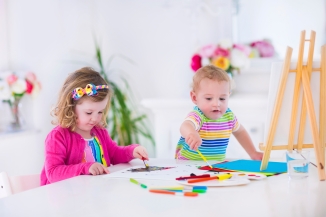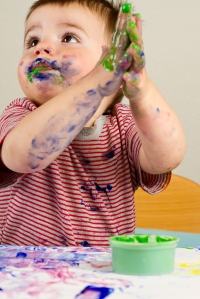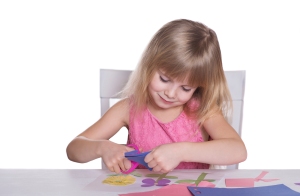 Arts and crafts help children experience and master a wide range of skills such as small motor control, eye-hand coordination, and concepts about color, size, shape, form, and texture. Art projects also help with language skills, sensory perception, independence, confidence, social skills, problem solving, and self-expression.
Arts and crafts help children experience and master a wide range of skills such as small motor control, eye-hand coordination, and concepts about color, size, shape, form, and texture. Art projects also help with language skills, sensory perception, independence, confidence, social skills, problem solving, and self-expression.
The concept of a child being able to develop something that is uniquely his or hers should be central to approaching this area. Remember that the process of creating is much more important to a child’s development than the result. As a parent, you should focus on being supportive of and interested in your child’s creative efforts. Avoid asking, “What is it?” Instead, say, “Tell me about your picture.”
Creativity and exploration can be encouraged by providing a variety of art materials that vary in color, texture, and scent. Children learn best from hands-on, open-ended activities that relate to things they are interested in and familiar with. Art supplies and tools can be common items presented in a new way. For example, nature objects (pine cones, leaves, etc.) can make interesting paint brushes or printing tools.
 Art should be offered on a continual basis. Ideally, art supplies should be available to children throughout the day. If this is not practical for your situation, offer a more limited selection of materials, such as chalk boards with chalk, crayons and paper at an easel, or children’s scissors for cutting and glue sticks for pasting. Messy art activities could be offered several times a week around a kitchen table or other location that offers easy clean-up, such as outdoors.
Art should be offered on a continual basis. Ideally, art supplies should be available to children throughout the day. If this is not practical for your situation, offer a more limited selection of materials, such as chalk boards with chalk, crayons and paper at an easel, or children’s scissors for cutting and glue sticks for pasting. Messy art activities could be offered several times a week around a kitchen table or other location that offers easy clean-up, such as outdoors.
Arts and crafts should be FUN for children! They can be used to celebrate and teach seasons, holidays, and special events. Alter projects according to the needs and interests of your child.
To Encourage Creativity:
- Provide opportunities. It is the adult’s job to provide a setting, materials, and encouragement…not to do the project for the child. Children should be allowed to cut, glue, and design on their own.
- Allow for individuality. Each child’s artwork should be unique. There should be no “right” or “wrong” way to use materials. Support children’s ideas!

- Children should be allowed to choose whether or not they participate. They will not always be interested in participating in art activities. Children learn best when they are given choices.
To Encourage Art Appreciation:
- Hang master artwork prints at your child’s eye level so they can study the paintings up close. Discuss the prints with your child. What colors, shapes, and objects can your child identify in the picture? For example, in Hand with Bouquet by Pablo Picasso, a child can identify flowers and hands. Pretend to “jump” into the picture with your child. Tell a story together about what it is like to be “in” the picture.
- Visit an art museum or art exhibits in your area. Even a trip to a local craft show will introduce your child to the many different forms of art.
- Help your child describe items they see in art. How are art and life related? Discuss emotions shown on faces in various paintings and photographs. How does your child express his or her emotions?
Explore the world of art with your child. Try not to limit his or her concept of art to illustrations in favorite storybooks. Exposing children to interesting works by famous artists helps to build an early appreciation for the beauty of many kinds of art.
Back to blog listing